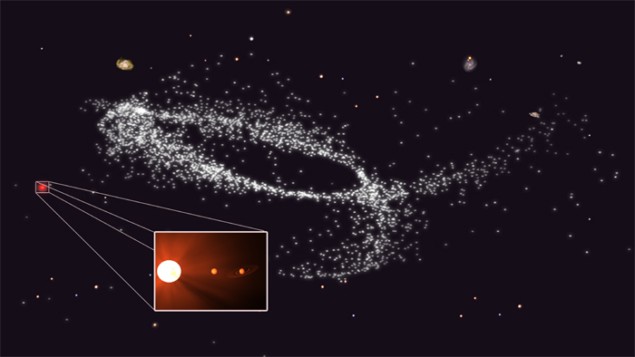
An international team of astronomers has uncovered the most ancient habitable exoplanet found to date. The discovery is all the more interesting because the planet originated outside of our Milky Way galaxy. At around 11.5 billion years old, the super-Earth is more than twice as old as our own planet and shows that habitable worlds were around much earlier in the universe’s history than previously thought.
The highly unusual find came from a survey of nearby, low-mass stars led by Guillem Anglada-Escudé of Queen Mary University of London. As part of their trawl, the researchers observed Doppler shifts in the light from Kapteyn’s star. Named after the Dutch astronomer who discovered it, it is one of the nearest stars to the Sun at just 13 light-years away. The Doppler shifts observed by the team were caused by two planets gravitationally tugging on their host and causing it to move slightly towards and away from the Earth. The researchers used new data from the HARPS spectrograph at the European Southern Observatory’s La Silla observatory, the Planet Finding Spectrograph at the Magellan/Las Campanas Observatory in Chile, and the HIRES instrument at the W M Keck Observatory in Hawaii to measure tiny periodic changes in the motion of the star.
In the zone
The team was able to infer that the two planets have orbital periods of 48 days and 121 days, respectively. As the star is a cooler red dwarf, its habitable zone is much closer than that of the Sun. This means that, despite its relatively proximity to its parent star, the innermost planet – dubbed Kapteyn b – should be able to support liquid water. It is thought to be a rocky super-Earth that is about five times more massive than our planet.
A super-Earth that lies within the habitable zone of a red-dwarf star has been found before. What makes this discovery unique, however, is the troubled history of Kapteyn’s star. “It has a very high velocity and a peculiar trajectory – it is not following the other stars around the galaxy,” Anglada-Escudé told physicsworld.com. Most of the stars in the Milky Way orbit slowly around the galactic centre, in the same plane. Astronomers believe that Kapetyn’s star bucks this trend because it did not form inside the Milky Way but rather was dragged into our galaxy at an angle at some later point from a dwarf galaxy that has now merged with the Milky Way.
Extragalactic voyage
This means the conditions that allow the formation of rocky planets in the habitable zones of stars were present in the universe long before the Sun was around Guillem Anglada-Escudé, Queen Mary University of London
The origins of Kapteyn’s star have been traced back to the ancient globular cluster Omega Centauri, the largest such object in orbit around our galaxy. That makes the star 11.5 billion years old – it formed just two billion years after the Big Bang. The planets encircling it are just as ancient and survived their host’s capture by the Milky Way. “We believe that these planets formed around the star – it would be almost impossible for the star to capture these planets at a later date,” says Anglada-Escudé. “This means the conditions that allow the formation of rocky planets in the habitable zones of stars were present in the universe long before the Sun was around,” he adds. It was previously thought that there were not sufficiently heavy elements around in the universe’s infancy with which to construct heavy, rocky planets.
According to Carole Haswell of the Open University in the UK, the finding adds to a growing realization that planets with significantly different histories to Earth might still be capable of hosting life. “It’s beginning to look as though habitable environments are plentiful and persistent in the galaxy,” she told physicsworld.com.
The paper has been accepted for publication in the Monthly Notices of the Royal Astronomical Society; a preprint of the work is available on the arXiv server.



